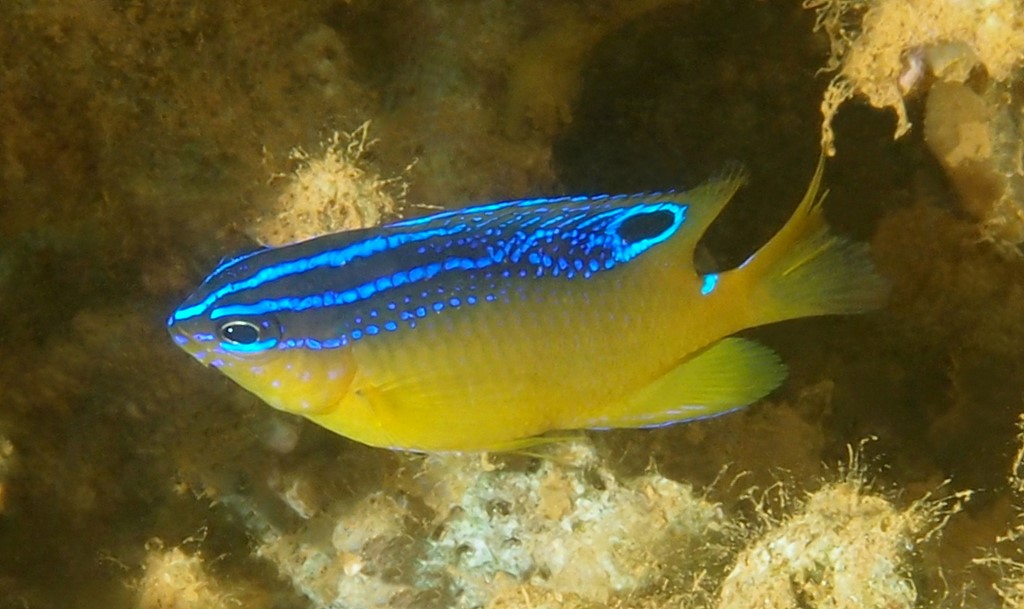POMACENTRUS GRAMMORHYNCHUS - (FOWLER, 1918)
Actinopterygii (Gigaclass) > Actinopteri (Class) > Teleostei (Subclass) > Blenniiformes (Order) > Pomacentridae (Family) > Pomacentrinae (Subfamily) > Pomacentrus (Genus)
Poisson demoiselle à point bleu, Bluespot damsel, Azurespot damselfish, Orange-tail damsel, 蓝点雀鲷, 藍點雀鯛,
Synonyme
Pomachromis grammorhynchus (Fowler, 1918)
-------------------------
Description
Dorsal spines (total): 13; Dorsal soft rays (total): 14-15; Anal spines: 2; Anal soft rays: 14-15; Pectoral fin rays: 17-18; Lateral line scales: 16-17; Gill rakers: 26-30; Body depth: 1.8-2.0 in SL; No pungent spine-like procurrent rays in caudal fin; Suborbital naked; Margin of preopercle and suborbital serrate; Teeth biserial. Max. length: 9.0 cm SL. Depth range: 2 - 12 m.
Color
Overall yellow tan to dark brown, operculum and cheek vermiculations lavender, last dorsal rays base with saddle-like spot blue. Juvenile bright yellow, dorsal side black with stripes blue. Distinctive blue spot on top of the caudal peduncle. Adults have a bright yellow spot above the pectoral fin base.
Etymology
Pomacentrus: from Greek, poma, -atos = cover, operculum + from Greek, kentron = something with a sharp point: point, spike, spur, sting, quill, thorn. Referring to serrations and prickles along margins of opercular bones of Pomacentrus pavo.
grammorhynchus: from Greek, gramma = mark + from Greek, rhynchos = beak. Referring to dusky line from snout tip to eye.
Original description: Pomacentrus grammorhynchus Fowler, 1918 - Type locality: Philippines.
Distribution
Western Pacific: South China Sea and eastern Indonesia east to Philippines and Papua New Guinea, north to Taiwan, south to northern Australia and New Caledonia.
Biology
Adults inhabit lagoons and passages among branching corals. They occur solitarily or in small groups. Feed mainly on benthic algae. Oviparous, distinct pairing during breeding. Eggs are demersal and adhere to the substrate. Males guard and aerate the eggs. Diurnal species.
Similar species
Pomacentrus wardi (Whitley, 1927) - Reported from Southwestern Pacific: Great Barrier Reef (Queensland) south to Sydney (New South Wales, Australia). Pomacentrus wardi, lacks the blue spot on the upper part of the caudal peduncle and has a large black blotch on the pectoral-fin base. Juvenile Pomacentrus wardi have broader blue lines on the head and a larger spot on the caudal peduncle.
Last update: 24, April 2022
Poisson demoiselle à point bleu, Bluespot damsel, Azurespot damselfish, Orange-tail damsel, 蓝点雀鲷, 藍點雀鯛,
Synonyme
Pomachromis grammorhynchus (Fowler, 1918)
-------------------------
Description
Dorsal spines (total): 13; Dorsal soft rays (total): 14-15; Anal spines: 2; Anal soft rays: 14-15; Pectoral fin rays: 17-18; Lateral line scales: 16-17; Gill rakers: 26-30; Body depth: 1.8-2.0 in SL; No pungent spine-like procurrent rays in caudal fin; Suborbital naked; Margin of preopercle and suborbital serrate; Teeth biserial. Max. length: 9.0 cm SL. Depth range: 2 - 12 m.
Color
Overall yellow tan to dark brown, operculum and cheek vermiculations lavender, last dorsal rays base with saddle-like spot blue. Juvenile bright yellow, dorsal side black with stripes blue. Distinctive blue spot on top of the caudal peduncle. Adults have a bright yellow spot above the pectoral fin base.
Etymology
Pomacentrus: from Greek, poma, -atos = cover, operculum + from Greek, kentron = something with a sharp point: point, spike, spur, sting, quill, thorn. Referring to serrations and prickles along margins of opercular bones of Pomacentrus pavo.
grammorhynchus: from Greek, gramma = mark + from Greek, rhynchos = beak. Referring to dusky line from snout tip to eye.
Original description: Pomacentrus grammorhynchus Fowler, 1918 - Type locality: Philippines.
Distribution
Western Pacific: South China Sea and eastern Indonesia east to Philippines and Papua New Guinea, north to Taiwan, south to northern Australia and New Caledonia.
Biology
Adults inhabit lagoons and passages among branching corals. They occur solitarily or in small groups. Feed mainly on benthic algae. Oviparous, distinct pairing during breeding. Eggs are demersal and adhere to the substrate. Males guard and aerate the eggs. Diurnal species.
Similar species
Pomacentrus wardi (Whitley, 1927) - Reported from Southwestern Pacific: Great Barrier Reef (Queensland) south to Sydney (New South Wales, Australia). Pomacentrus wardi, lacks the blue spot on the upper part of the caudal peduncle and has a large black blotch on the pectoral-fin base. Juvenile Pomacentrus wardi have broader blue lines on the head and a larger spot on the caudal peduncle.
Last update: 24, April 2022
